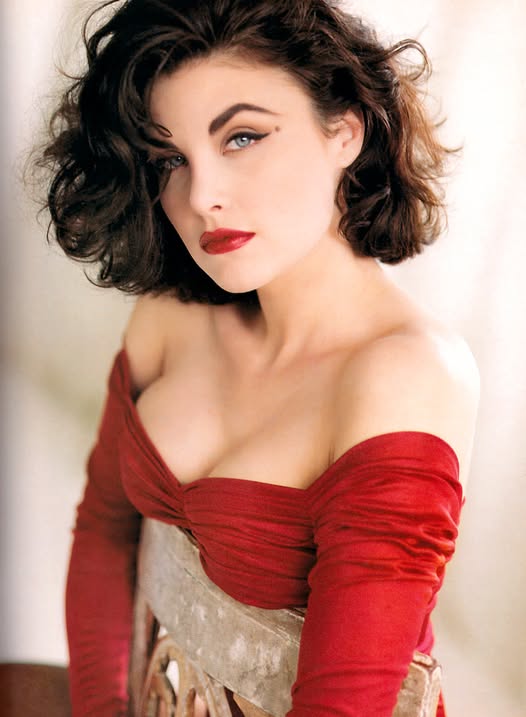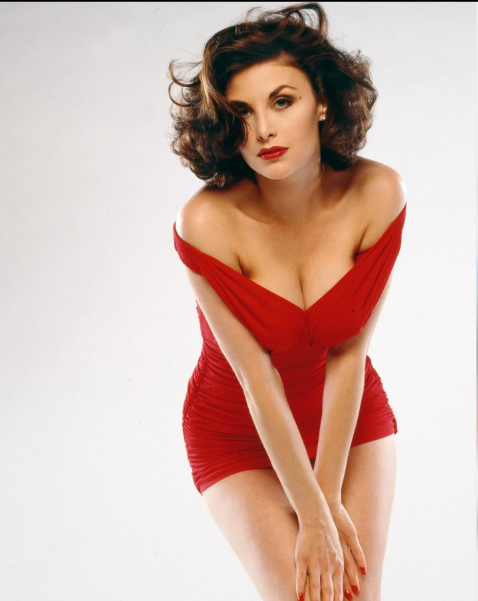On this very day in 1990, a studio portrait was taken — a still frame that would later become emblematic of one of the most captivating figures of her time. With a face reminiscent of Old Hollywood starlets and a magnetic presence that was impossible to ignore, Sherilyn Fenn redefined what it meant to be a femme fatale for a new era.

Born Sheryl Ann Fenn in Detroit, Michigan, in 1965, Sherilyn came from a family with creative roots — her mother was part of a 1960s all-girl rock band. After a restless childhood marked by frequent moves, Fenn eventually settled in Los Angeles and took acting classes, quickly realizing that she didn’t want to follow the usual Hollywood path. She wasn’t interested in being a cookie-cutter beauty. Instead, she wanted to become a character actress — someone who told stories with her eyes, her silence, her contradictions.
And then came Audrey Horne.
In 1990, David Lynch cast Fenn in Twin Peaks, a surreal television drama that would change the landscape of network television forever. As Audrey, the cigarette-smoking, saddle-shoed daughter of a wealthy tycoon, Fenn created a character who was both innocent and dangerous, childlike and deeply sensual. Her iconic scene — dancing alone in the Double R Diner to haunting jazz music — became a cultural touchstone and a moment of pure cinematic magic.
Fenn didn’t just play Audrey; she became her. Her chemistry with co-star Kyle MacLachlan was so electric that viewers clamored for the characters to be romantically involved. However, MacLachlan, uncomfortable with the idea of his character romancing a high schooler, resisted — and Lynch pivoted. Yet the impact was already made. Fenn had arrived, and she stole every scene she was in.

But Sherilyn Fenn was never content to ride on the coattails of fame.
After Twin Peaks, she took on a series of eclectic roles in both indie and mainstream films, including Of Mice and Men (1992), Boxing Helena (1993), and Just One of the Guys (1985). Each performance reinforced her range and her refusal to be pigeonholed as just another pretty face.
Off-screen, Fenn was fiercely independent. She resisted the expectations placed upon young actresses in Hollywood, often challenging the industry’s obsession with youth and conformity. Her interviews from the 1990s reflect a woman deeply aware of her place in an unforgiving system, but also someone who refused to let it define her.

Her beauty — often compared to legends like Ava Gardner and Elizabeth Taylor — was undeniable. But what made her unforgettable was her ability to convey vulnerability, strength, seduction, and sadness in a single look. She had that rare quality: presence. And whether she was the lead or in a supporting role, you couldn’t take your eyes off her.
As the years passed, Fenn transitioned gracefully into motherhood, activism, and selective acting roles. She became an advocate for mental health and spiritual growth, often writing about her own personal journey through trauma, healing, and self-discovery. In many ways, her real-life evolution mirrored the complexity of the characters she once portrayed.

Today, Sherilyn Fenn is regarded not just as a muse of 1990s pop culture, but as a symbol of resistance against Hollywood’s rigid expectations. She remains a beloved figure among cinephiles and Twin Peaks devotees — a reminder of a time when television dared to be strange, and actresses were allowed to be mysterious.
That 1990 portrait, with its classic lighting and her piercing gaze, captures more than just a pretty face. It captures the essence of a woman who challenged the rules, embraced her quirks, and made an indelible mark on film and television history.